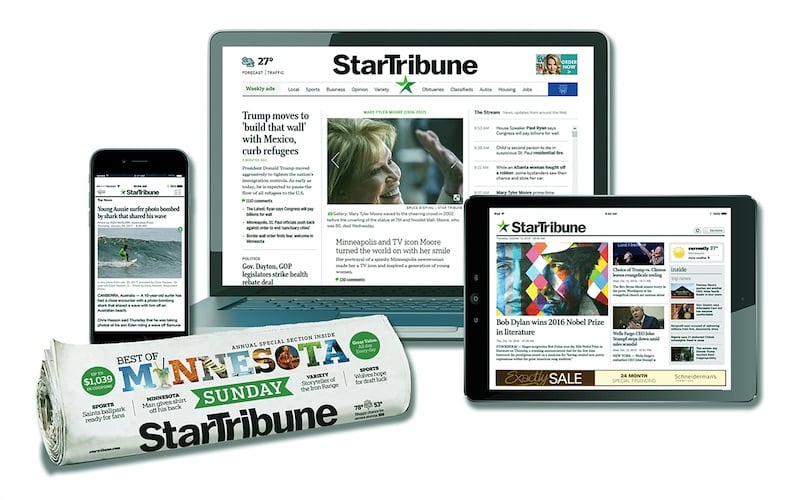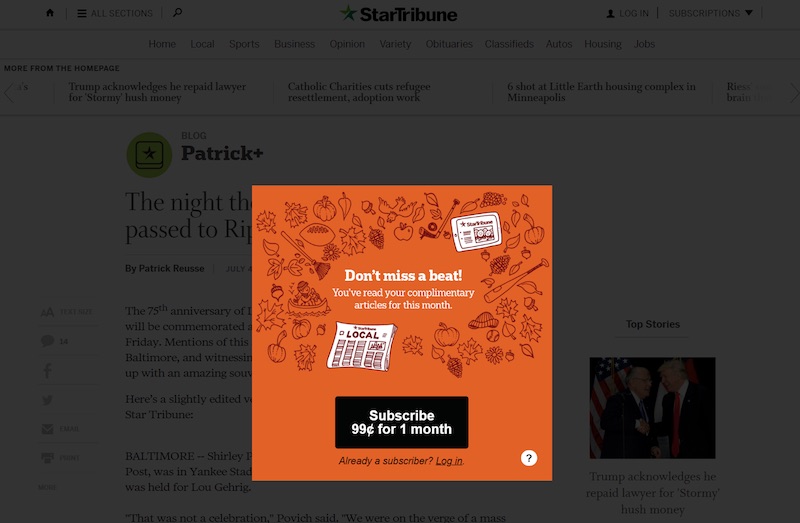Wie die Star Tribune das Volumen der digitalen Abonnements um 35% steigerte
Ein Verlag macht weiterhin Schlagzeilen, indem er Herausforderungen durch Experimentieren meistert
Nach anderthalb Jahrhunderten der Berichterstattung über die für Minnesota wichtigsten Nachrichten wollte die Star Tribune ihre digitale Reichweite in einem allzu wettbewerbsintensiven Markt ausbauen. Mit Optimizely und seiner robusten Plattform zum Experimentieren konnte die Star Tribune ihren digitalen Abonnentenstamm vergrößern und ein besseres Gleichgewicht zwischen Verbraucher- und Werbeeinnahmen finden.

Digital zu werden war nicht genug
Die Star Tribune war nach der New York Times das erste große Nachrichtenunternehmen, das ein digitales Abonnementprodukt einführte. Und obwohl die ersten Ergebnisse vielversprechend aussahen, gingen die Verkäufe 2015 zurück, obwohl das Unternehmen seine Site neu gestaltet und das Marketing für den digitalen Kanal verbessert hatte. Das Geschäft stagnierte.
Nur ein Jahr zuvor hatte Johnston an dem Team teilgenommen. Ihm fiel auf, dass es zwar reichlich Daten zur Entscheidungsfindung gab, aber keine Methodik zum Experimentieren, um die praktischen Auswirkungen der Daten auf die Geschäftsfunktionen zu verstehen. Es war klar, dass das Unternehmen von einer ganzheitlichen Methode zur Messung der schrittweisen Auswirkungen der verschiedenen Änderungen, die sie an ihrem digitalen Journalismus und ihren Werbeprodukten vornahmen, profitieren könnte, insbesondere wenn man saisonale Schwankungen und den sich ständig ändernden Nachrichtenzyklus berücksichtigt.
Die vielleicht drängendste Herausforderung war die Frage, wie die Einnahmen der Site am besten optimiert werden können. Mit dem Konzept der Bezahlschranke konnten sie den Website-Traffic stabil halten, um ausreichend Werbung zu verkaufen. Aber wenn sie mehr Besucher aufforderten, Abonnenten zu werden, konnten sie die Einnahmen aus der Auflage erhöhen. Irgendwo dazwischen lag die Antwort.

Testen der Hypothese
Johnston war davon überzeugt, dass StarTribune.com optimale Einnahmen erzielen könnte, indem es die Anzahl der kostenlosen Artikel verringert, die die Besucher aufrufen können, bevor sie zu einem Abonnement aufgefordert werden. Er stellte die Hypothese auf, dass eine Steigerung der Abonnementeinnahmen jeden Rückgang des Engagements ausgleichen könnte, der sich auf die Werbeeinnahmen auswirkt.
Mit Optimizely X Web Personalization experimentierte das Team von Johnston mit drei Testvarianten. Das erste und aktuelle Angebot umfasste 10 kostenlose Artikel, bevor die Leser ein Abonnement abschließen mussten. Die zweite Variante ermöglichte den Zugang zu 7 kostenlosen Artikeln. Die letzte Version bot 5 kostenlose Artikel.
Sie gingen davon aus, dass das Experiment mit 5 Artikeln die höchste Abonnementrate erzielen würde, weil es die Leser früher unterbricht. Was sie entdeckten, überraschte sie.

Die Erwartungen wurden übertroffen
Die 5-Artikel-Variante übertraf die 10-Artikel-Variante mit einem Anstieg der Abonnementeinnahmen um 49% und einem Rückgang der Anzeigeneinnahmen um -12%, was zu einem Anstieg der Gesamteinnahmen um +15% führte. Bei der 7-Artikel-Variante hingegen stiegen die Abonnementeinnahmen um +37%, während die Werbeeinnahmen nur halb so stark zurückgingen (-6%), was zu einer Steigerung der Gesamteinnahmen um +20% gegenüber der 10-Artikel-Variante führte.
Johnston räumt ein, dass man ohne das Experiment wahrscheinlich mit dem 5-Artikel-Angebot fortgefahren wäre und die Einbußen bei den Werbeeinnahmen in Kauf genommen hätte, wodurch man die Gelegenheit verpasst hätte, herauszufinden, was tatsächlich am besten funktioniert. Die Tatsache, dass das Team in der Lage war, die Veränderungen bei den Abonnementraten und dem Anzeigenengagement zu berücksichtigen, weckte auch das Interesse, weitere Tests mit Funktionen wie personalisierten Artikel-Empfehlungen und Newsletter-Akquise durchzuführen, um das Customer Engagement zu steigern. Letztendlich gelang es dem Team, die Abonnementzahlen im Vergleich zum Vorjahr um 35 % zu steigern.

Eine totale Veränderung
Johnston ist heute davon überzeugt, dass das Experimentieren sein Unternehmen völlig verändert hat: "Wir sitzen nicht mehr am Tisch und diskutieren über Ahnungen und Meinungen", gesteht er, "sondern wir probieren die Dinge mit einem kleinen Prozentsatz unseres Traffics aus, mit offenem Geist und in gespannter Erwartung."
Er hat auch eine Botschaft für diejenigen, die gerade erst in die Welt des Experimentierens eintauchen: "Die Vorstellung, Ihre Site einer neuen Plattform, Experimenten und Personalisierung zu unterziehen, kann ziemlich einschüchternd sein", sagt Johnston und merkt an: "Wenn man erst einmal angefangen hat, merkt man, dass es gar nicht so beängstigend ist und das Risiko von Änderungen tatsächlich mindert."
Die vielleicht überzeugendste Beobachtung, die Johnston machte, war folgende: Experimentieren verändert die Menschen. Sie fangen an, anders zu denken, fühlen sich stärker involviert, sehen die Auswirkungen ihrer Ideen, und das bringt eine enorme Befriedigung mit sich.

Gerade erst angefangen
Nachdem die Einnahmen der Site gestiegen sind, will sich Johnstons Team nun auf die Pflege der Kundenbeziehungen konzentrieren. Natürlich wollen sie die Art und Weise verbessern, wie sie Nicht-Abonnenten durch den Trichter der Conversion führen, aber sie wollen auch die Vorlieben der Kunden verstehen und in der Lage sein, das Erlebnis jedes Kunden zu personalisieren.
"Ich bin der festen Überzeugung, dass die Möglichkeit, schnell Änderungen vorzunehmen, die Auswirkungen zu sehen und dann zur nächsten Idee überzugehen, entscheidend für unseren Erfolg im vergangenen Jahr war." - Patrick Johnston
Dank Optimizely ist Johnston zuversichtlich, dass sie in jeder Phase ihrer Reise einen Mehrwert schaffen können.


